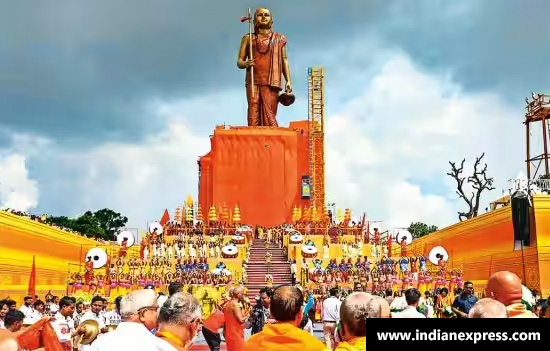- Why
the name Omkareshwar? About Omkareshwar Parikrama. Traditions
of Omkareshwar. What all to see in Omkareshwar? Why is Adi Sankaracharya
connected with Omkareshwar?
Omkareshwar is a temple of Lord Shiva situated on the north bank of the
Narmada River near Khandwa in Madhya Pradesh, about 78 km from Indore.
This article was
first published in the Bhavan Journal.
It is the only Jyotirlinga located along the north bank of a river. This
Jyotirlinga is swayambhu (self-manifested). The word ‘OMKAR’ is derived from the divine word ‘Om’, pronounced before every prayer.
Om (P) is the ‘Mool Mantra’ of the four Vedas, 18 Puranas and countless Shastras.
Here, the sacred sister rivers Narmada and Kaveri meet, separate and reunite, never parting again. This natural confluence forms an island shaped like the sacred symbol ‘OM’, known as Omkar Parvat. This island is called Mandhata or Shivapuri, and seen from above, it takes the shape of the word ‘Om’ (sacred Hindu symbol). Hence, this place got the name Omkareshwar.
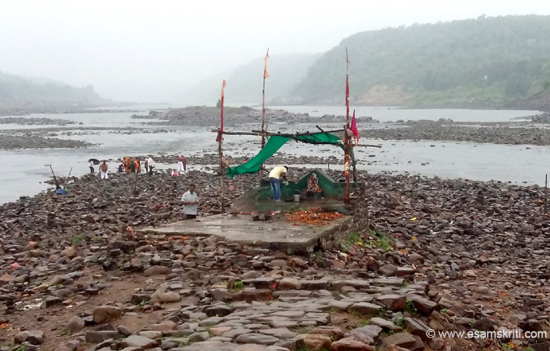 Sangam of Narmada and Kaveri rivers. 2018.
Sangam of Narmada and Kaveri rivers. 2018.
This temple is the only place where Lord Shiva appeared in an ‘Omkara Swaroopa’.
There are two temples situated on the island—Omkareshwar and Amareshwar. So here the idol of Lord Shiva is situated on both the banks of the river. The Narmada, also known as Rewa or Mekal Kanya, is the largest river in Central India and the fifth-largest in the Indian subcontinent. The river flows for 1,312 kilometres in the west direction, from its origin in Madhya Pradesh’s Satpura hills to its confluence with the Arabian Sea at the Gulf of Khambhat in Gujarat, passing through Madhya Pradesh, Maharashtra and Gujarat.
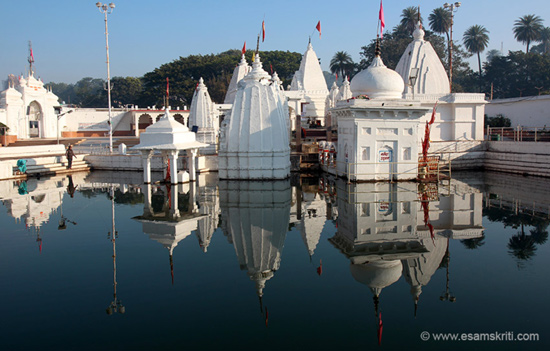 Source of Holy Narmada is at Amarkantak in Madhya Pradesh. 2018.
Source of Holy Narmada is at Amarkantak in Madhya Pradesh. 2018.
Just like the Salagrama stone from Nepal represents Lord Vishnu, the Bana Linga
stones from the Narmada river represent Lord Shiva. Bana Lingas can be seen in
temples all over Omkareshwar and wherever the Narmada river flows.
This temple is built in the Nagara style of architecture with elaborate and
intricate carvings. It is a five-storey structure where Lord Omkareshwar is
present in different forms.
 Temple view from a distance. Left temple. Guru Nanak visited, close to temple is a Gurdwara. 2018.
Temple view from a distance. Left temple. Guru Nanak visited, close to temple is a Gurdwara. 2018.
Ground or First Floor: Omkareshwar Jyotirlinga
Second Floor: Mahakaleshwar
Third Floor: Siddhanath
Fourth Floor: Kedareshwar
Fifth Floor: Gupteshwar, also known as Ghaneshwar Jaldhari by many devotees.
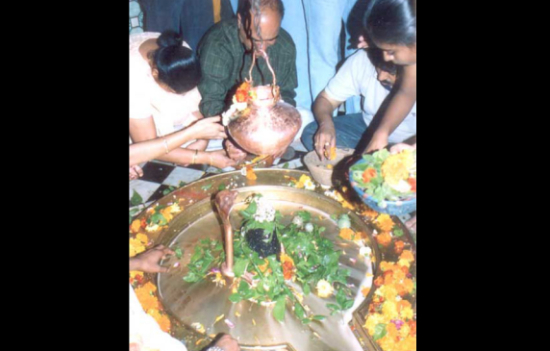 Devotees worshipping the Linga at Omkareshwar Temple. 2006.
Devotees worshipping the Linga at Omkareshwar Temple. 2006.
The temple’s courtyards and corridors are adorned with artwork that narrates stories of devotion and mysticism. The Shiva Lingam is on the ground floor of the temple, and it is immersed in water. It receives a daily abhishekam that is made of milk, curd and water from the Narmada river, and this happens three times a day. Like the Bhasma Aarti of Mahakaleshwar Jyotirlinga in Ujjain, the Shayan Aarti of
Omkareshwar temple is world-famous. It is believed that after traversing the
three worlds daily, Lord Shiva rests here.
Therefore, special sleeping arrangements, rituals, and Shayan Darshan of
Shiva are arranged here. Right behind the Linga is a silver image of Goddess
Parvati. In front of that, a bed is laid out for Lord Shiva and Goddess Parvati
and alongside it, a chaupar for them to play chausar before sleeping. It is said
that every morning, chausar and dice are found scattered in such a way, as if
someone has played it during the night!
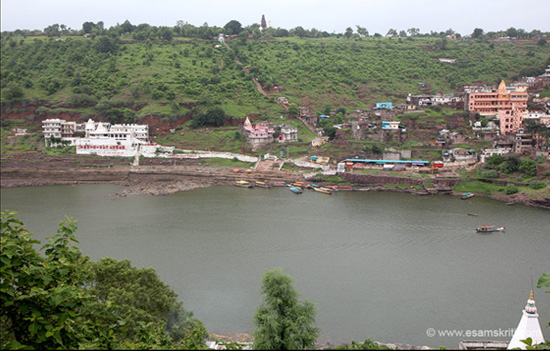 View of Island
from one side of the Narmada. Parikrama
& Ashrams on island.
View of Island
from one side of the Narmada. Parikrama
& Ashrams on island.
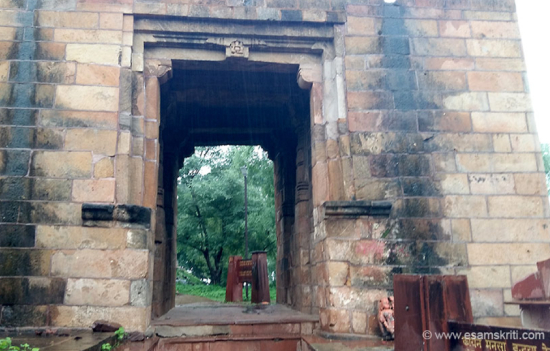 Start to Parikrama. Dharamraj Dwar. Constructed in 13th century by Parmar
Rulers. It is Western gateway of Mandhata Fort.
Start to Parikrama. Dharamraj Dwar. Constructed in 13th century by Parmar
Rulers. It is Western gateway of Mandhata Fort.
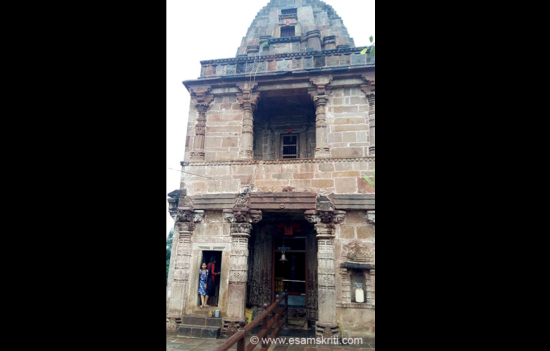 Gauri Somnath Temple enroute.
Gauri Somnath Temple enroute.
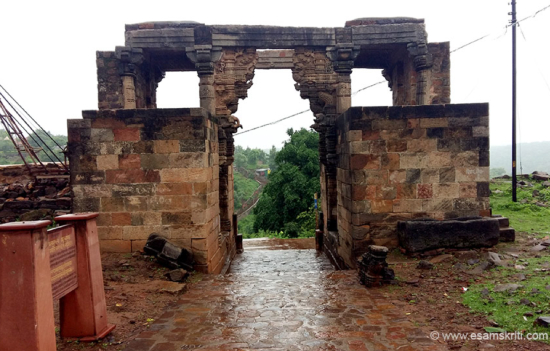 End of Parikrama gate. Good view of Narmada from here.
End of Parikrama gate. Good view of Narmada from here.
 Sculpture part of the gate. Mahisuramardhini.
Sculpture part of the gate. Mahisuramardhini.
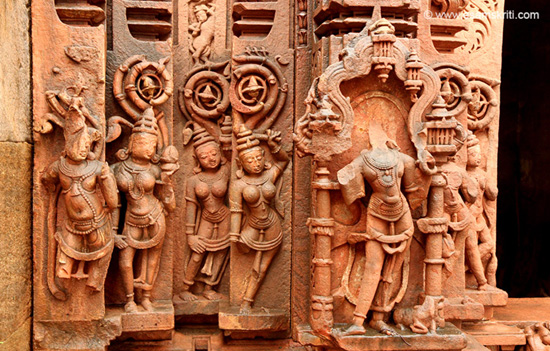 Siddhanath Mandir enroute to Ma Narmada. Must see.
Siddhanath Mandir enroute to Ma Narmada. Must see.
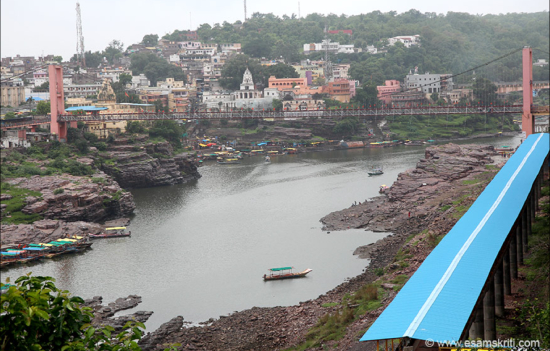 Complete parikrama fully and back to Ma Narmada banks.
Complete parikrama fully and back to Ma Narmada banks.
There is a short Narmada parikrama path of 7 km, adorned with ancient
temples, ashrams, lush greenery, red-faced monkeys, and inscriptions of Gita
shlokas along the way. According to the temple priests, if you do a parikrama (circumambulation)
of the temple, it will lead you to a good life and moksha (salvation) after
death. The parikrama of this divine land, called Omkareshwar Parikrama, symbolises
the journey to become closer to Lord Shiva.
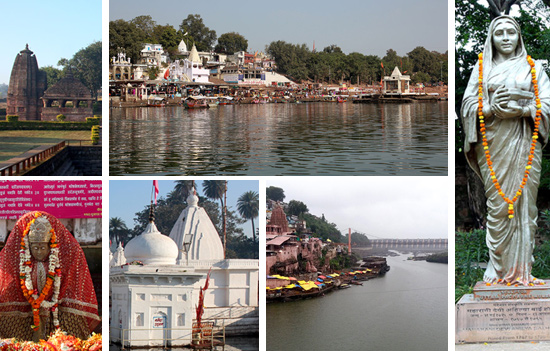 Parikrama Collage.
Parikrama Collage.
There is a larger Narmada Parikrama undertaken by many sadhus which is over
2700 km and takes several months. Read About
the Narmada Parikrama
Narmada Jayanthi or Narmada Janmotsav is like the Chhath Puja celebrated
for the river Ganga. It usually occurs in the month of Magh. It is celebrated
with great variety and splendour. Special pujas are offered to the Narmada river along with the Maha Aarthi and in the evenings, lamps
are lit across all the bathing ghats of the river. It is also accompanied by fireworks
and the distribution of food to the poor.
Omkareshwar city is divided into three ‘Puris’.
1. Brahmapuri: There is a temple of Lord Brahma on the
southern bank of Narmada.
2. Vishnupuri: There is a temple of Lord Vishnu.
3. Shivpuri: There is a temple of Lord Omkareshwar here.
Legends associated with the Omkareshwar Temple
According to one legend, Narada (son of Brahma) visited Vindhya
parvat. When he stated that the Meru parvat was larger, Vindhya parvat was
jealous. Then, Vindhya began praying to Lord Shiva to bless him and make him taller. Shiva granted Vindhya his boon that he would never stop growing but
in return took a promise that Vindhya should not cause any problems for the
people. But Vindhya dishonoured his promise. The Vindhya mountains were growing
taller and were challenging the Himalayas, which were considered the highest mountains
on earth.
This growth of Vindhya threatened to block the path of the sun, causing darkness on earth. All deities approached Sage Agastya for help. Agastya, a devotee of Lord Shiva, travelled to the Vindhya mountains and asked them to bow down in reverence to Lord Shiva. The Vindhya mountains obeyed the sage’s request and bowed down, stopping their growth.
Sage Agastya and his wife made Vindhya promise that he would not grow until they returned. Vindhya agreed. The Sage and his wife left the place and stayed in Srisailam. According to the Puranas, the Vindhya Mountain performed penance appeared and blessed the mountain, manifesting as the ‘Pranav Lingam’. It is also said that after the prayers of the gods, the lingam was divided into two parts: one became Omkareshwar and the other, Mamleshwar. The Jyotirlinga is located at Omkareshwar, while the physical lingam is at Mamleshwar or Amreshwar. While Mamleshwar was an earthly linga, Omkareshwar was a Jyotir Linga (column of light).
 Mamleshwar Mandir.
Mamleshwar Mandir.
Another legend is that Narmada River was deeply in love with Lord Shiva and wanted to be close to him. Narmada performed severe penance. Touched by her devotion, Shiva granted her the boon that he would reside in the form of a Jyotirlinga on an island in the Narmada river. This island, which later came to be known as Omkareshwar, is considered a manifestation of Lord Shiva’s divine presence.
Another legend is that of King Mandhata from the Ikshvaku dynasty, an
ancestor in the 39th generation of Lord Ram. According to Hindu mythology, King
Mandhata was a righteous and pious ruler who performed intense penance to seek
the blessings of Lord Shiva. Pleased with his devotion, Lord Shiva appeared
before him and granted his wish. Mandhata asked for a divine lingam to be
established on an island in the Narmada river, and this island came to be known
as Omkareshwar.
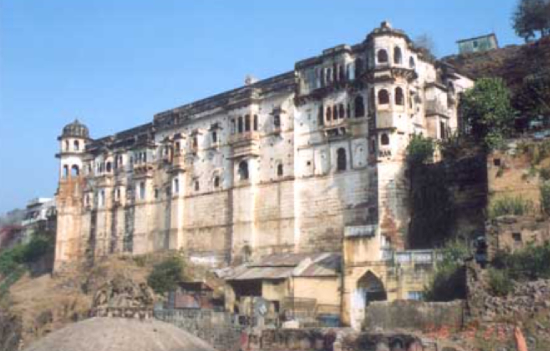 Mandhata Palace on island. 2006.
Mandhata Palace on island. 2006.
The glory of Omkareshwar is mentioned in ancient scriptures like the Skanda
Purana, Shiva Purana and Vayu Purana. The belief about this miraculous and mysterious
Jyotirlinga of Mahadev is that all the pilgrimages of a person are considered
incomplete without offering water to the Shivlinga of this temple. It is believed
that whoever worships Omkareshwar with an unshakeable faith in Mahadev will
attain relief from all the evils present on earth.
Many Hindu saints believe that worshipping the Omkareswar Jyotirlinga is
equal to worshipping the Panch Kedars. The holy scriptures present in the
temple indicate that the Omkareswar temple existed since at least 5,500 years
ago. During their period of exile (agyatvas), the Pandavas spent time on this
holy mountain, constructing several temples, many of which still stand today.
These ancient temples bear witness to the rich history and sanctity of Omkar
Parvat, drawing pilgrims and devotees who seek divine blessings from Lord Shiva
and the resident deities.
Archaeologists claim that the Jyotirlinga was originally inside a small
ancient temple surrounding which a larger complex was built.
In the 19th century, Holkar rulers (mainly Rani Ahalya Bai Holkar) rebuilt
the temple. A total of six pilgrimages and 68
shrines are located around Omkareshwar Jyotirlinga. Lord Shiva is seated
here with His family and 33 crore gods, making it a must-visit place for
devotees.
There is a cave below the Omkareshwar temple (Shri Govinda Bhagavatpada
cave) in which there is an image of Sri Adi Shankaracharya because it is the place
where he saw his guru, Sri Govindha Padacharya.
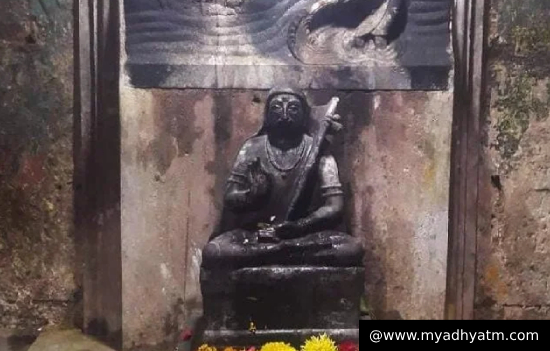 Murty of Adi Sankaracharya inside cave.
Murty of Adi Sankaracharya inside cave.
When Shankaracharya took up monastic life and set out in search of a qualified
guru, he met Sri Govindhapada here.
Shankaracharya was travelling from Kerala to Omkareshwar by foot. Sri
Govindhapada was staying in a cave in Omkareshwar, close to the river. Once he
met this Guru, he composed a mystic hymn called Atma Shatakam or Nirvana Shatakam, meaning ‘six verses of the eternal soul’. The cave had secret passages to the Narmada river but they are closed now.
The second time Shankaracharya met his guru was when the river Narmada was
in flood and his guru was in deep meditation, unaware of himself. Sri Shankara then
prayed to Narmada and the flood subsided. This incident is depicted in one of
the sculptures in the cave.
“Kaaverikaa Narmadyoh Pavitra
Samaagame, Sajjan Taaranaaye|
Sadaiva Mandhaatrapure
Vasantam, Omkaarmeesham
Shivayekameede ||”
(At the sacred confluence of the Kaveri and Narmada rivers, Bhagwan
Omkareshwar, who is self-manifested, resides eternally in the city of Mandhata,
also known as Shivpuri, and is the Jyotirlinga.)
This verse is composed by Adi Shankaracharya.
‘Om’ is the Mool Mantra which represents the essence of creation and existence, and is considered Lord Shiva himself, symbolising His omnipresence and eternal nature in the universe.
This article was first published in the Bhavan’s Journal, May 15-31, 2025 issue. This article is courtesy and copyright Bhavan’s Journal, Bharatiya Vidya Bhavan, Mumbai-400007. eSamskriti has obtained permission from Bhavan’s Journal to share. Do subscribe to the Bhavan’s Journal – it is very good.
Also read/see
1.
Album Omkareshwar
2006
2.
Album Onkareshwar
2018
3.
Album Siddhanath
Mandir
4.
Statue of Oneness,
Omkareshwar
